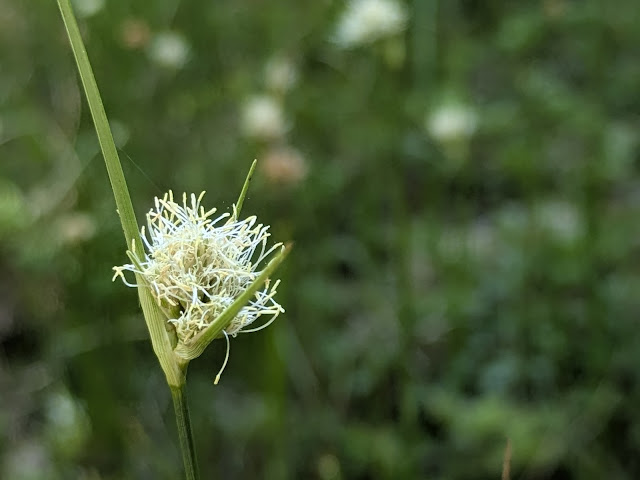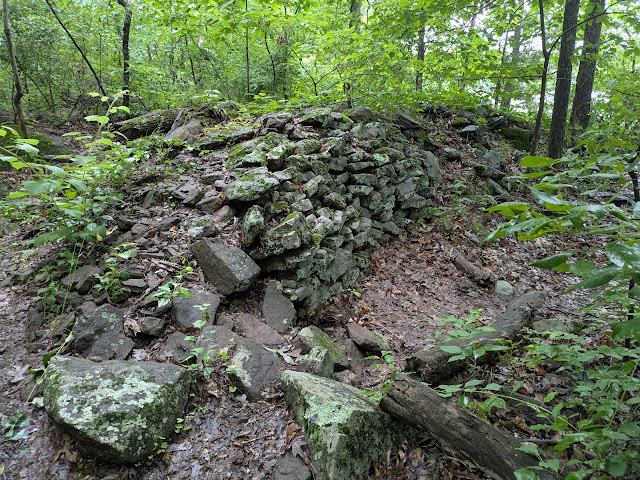On a very hot, humid day in the Allegheny Front region of Pennsylvania I decided a change of plans was needed to spare my not-so-heat-tolerant coonhound from another day in the sun-exposed bogs of the Gallitzin State Forest. We retreated instead to the nearby oak forests of Shawnee State Park, a few minutes east. I had just listened to the latest 1A podcast episode on Sam Bloch's new book Shade so of course I had to make some plant surveys! I chose a closed canopy 2 mile-long forested trail within the park but what I found there - besides being drastically cooler - was a real treat for me (and Amos).

Bloch describes how tree shade affects humans and animals biologically as a multi-layered canopy lowers air temperature on a hot day by as much as twenty degrees F. The heart rate slows down and the body's cooling mechanisms relax. Shady forests can even generate their own ground to canopy breezes which help with evaporative cooling. As we climbed up the slope to the broad knoll on top, the shade quality went from humid and deep to breezy and cool above. Amos even had a little fancy prance at just about 80 F' compared to his sluggish walk in the open bogs at 95 F' yesterday.
 |
| Chestnut Oak, Quercus montana |
As we hiked along the dry shady oak ridge of weathered sandstone, the cooling effect of the great old oaks was intoxicating. Acres of massive Chestnut and Chinquapin Oak, all of them hundreds of years old with their great out-sweeping limbs shaded patchy below-canopy grasslands spread across the forest floor like a vast carpet. But, unlike what I'm used to seeing in our acidic woods at home, there were no heath plants, no blueberry or huckleberry, no laurel or rhododendron understory, so I knew the soil composition was very different. I scuffed around in the duff which was very thin over light sandy soils that barely covered the sandstone bluff. The deeper we went down this old growth path the more I suspected that a unique kind of habitat, part woodland, part grassland, was unfolding in front of us.
 |
| Chinquapin Oak, Quercus muehlenbergii |
Aprons of grasses and small forbs grew in the distinctly circular canopy shadow beneath each of the giants. Beyond the aprons were small Sassafras, Shagbark Hickory, larger Cherry and Sweet Birch saplings all forming a ring of transition woodland around each of the giant oaks. Seeing the repeating pattern of open shaded grass glades beneath each of the old trees, mostly made up of native Poverty Oatgrass and Little Bluestem, I was sure I'd wandered into an Appalachian Oak Glade, one of Pennsylvania's most vulnerable Allegheny Mountain habitats. I stepped carefully into one of the large green patches beneath a Chinquapin Oak to survey what grew there.
 |
| Indian Tobacco |
 |
| Blue-Eyed Grass |
 |
| Grass Pink |
 |
| Poverty Oatgrass |
 |
| Pennsylvania Sedge |
The vulnerability of the Allegheny Oak Glad is concerned with invasive non-native plants and fire/grazing suppression. These little patches are little prairie oak savannas in miniature and they occupy mid-elevation southern facing outcrops with poor soils underlaid with calcium-bearing sandstone. Valued by indigenous people who lived in the Allegheny/Appalachian Valley and Ridge region these little oak glades attracted big game like White tailed Deer, Elk, and Bison. Controlled fire was used to sweep upslope to the summits to deter all but the toughest trees like Oak, Pitch Pine, and Chestnut while favoring the deep-rooted grasses and forbs that herbivores love.
 |
| Oak Glade in transition |
As settlement and cultivation overtook the fertile valleys and Shawnee peoples were forcibly moved off their ancestral homelands, farmers continued to use these open oak glades for summer livestock pasture. As Crosby (1986) described, the Neo-Europeans and their non-native livestock swarmed over the Alleghenies, "grunting, lowing, neighing, crowing, chirping, snarling, and buzzing in a self-replicating and world-altering avalanche." This activity bought the oak glade habitats a little more time until another invasion took hold. From DCNR flyers of non-native invasive plants, these were some of the most abundant invasives I noted in the little aprons of Oak Glade grasslands:


Now that controlled fire and intensive livestock grazing is all but gone over this sandstone knoll (being a protected landscape within the state park) the little patches of prairie beneath the old growth oaks are threatened with a number of invaders. Encroaching on the little grassland habitats were hundreds if not thousands of small sprigs of Japanese Barberry as far as the eye could see. Interspersed among these were Winter Creeper, an invasive vine that prefers open woodland, and a few dense stands of the prolific Common Velvet Grass, a common, aggressive European pasture grass that has made its way upslope from farms beyond the park.

So what? Isn't this just a little niche habitat doomed anyway to environmental change and not worth all the worry? To the everyday hiker a little disappearing oak glade may even be invisible, therefore not a concern at all as one goes on about her hike. But this is for me an example of living in Aldo Leopold's "world of wounds" where my love for ecological communities and environmental history can leave me feeling sad. Standing along the mile-wide knoll with all its many patches of oak glade grasslands tucked neatly into the cool, cast shadows of the giant tree canopies overhead, I saw the shade for what it provided this wild, increasingly warming world with its own special sanctuary from the sun - a place born of harsh, hot environments after all and that offers us the possibility of shady resilience against the onslaught of heat waves. Amos loved this slow paced walk among the old trees so much that he gave a few of them a loud HELLLOOOOO!
Notes:
Alfred W. Crosby. 1986. Ecological Imperialism: The Biological Expansion of Europe, 900 - 1900. Cambridge University Press.
Common Velvet Grass https://elibrary.dcnr.pa.gov/GetDocument?docId=3643509&DocName=Velvetgrass.pdf
Winter Creeper https://elibrary.dcnr.pa.gov/GetDocument?docId=1738762&DocName=winter%20creeper.pdf
Asian and European Barberry https://elibrary.dcnr.pa.gov/GetDocument?docId=3549861&DocName=Barberry.pdf
 |
| Shawnee Trail, Shawnee State Park, PA |
















































































